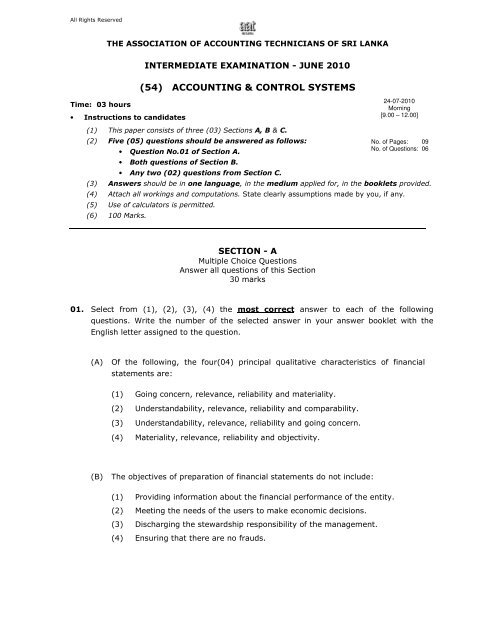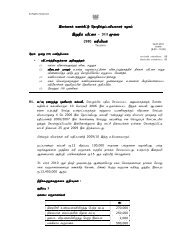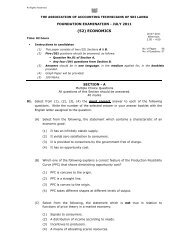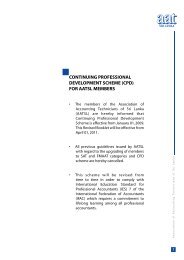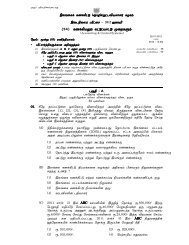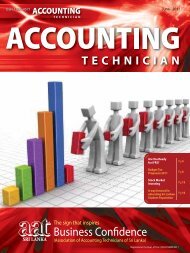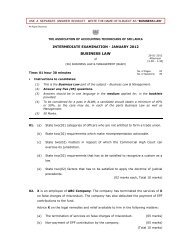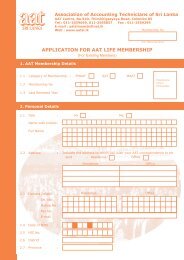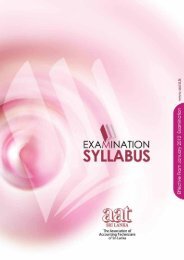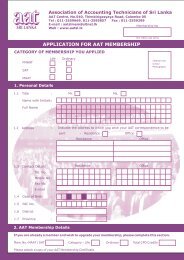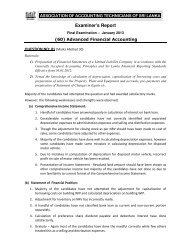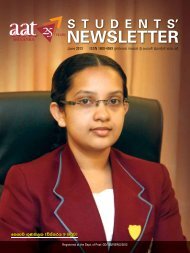(54) ACCOUNTING & CONTROL SYSTEMS - AAT
(54) ACCOUNTING & CONTROL SYSTEMS - AAT
(54) ACCOUNTING & CONTROL SYSTEMS - AAT
Create successful ePaper yourself
Turn your PDF publications into a flip-book with our unique Google optimized e-Paper software.
All Rights Reserved<br />
Time: 03 hours<br />
THE ASSOCIATION OF <strong>ACCOUNTING</strong> TECHNICIANS OF SRI LANKA<br />
• Instructions to candidates<br />
INTERMEDIATE EXAMINATION - JUNE 2010<br />
(<strong>54</strong>) <strong>ACCOUNTING</strong> & <strong>CONTROL</strong> <strong>SYSTEMS</strong><br />
(1) This paper consists of three (03) Sections A, B & C.<br />
(2) Five (05) questions should be answered as follows:<br />
• Question No.01 of Section A.<br />
• Both questions of Section B.<br />
• Any two (02) questions from Section C.<br />
(3) Answers should be in one language, in the medium applied for, in the booklets provided.<br />
(4) Attach all workings and computations. State clearly assumptions made by you, if any.<br />
(5) Use of calculators is permitted.<br />
(6) 100 Marks.<br />
SECTION - A<br />
Multiple Choice Questions<br />
Answer all questions of this Section<br />
30 marks<br />
01. Select from (1), (2), (3), (4) the most correct answer to each of the following<br />
questions. Write the number of the selected answer in your answer booklet with the<br />
English letter assigned to the question.<br />
(A) Of the following, the four(04) principal qualitative characteristics of financial<br />
statements are:<br />
(1) Going concern, relevance, reliability and materiality.<br />
(2) Understandability, relevance, reliability and comparability.<br />
(3) Understandability, relevance, reliability and going concern.<br />
(4) Materiality, relevance, reliability and objectivity.<br />
(B) The objectives of preparation of financial statements do not include:<br />
(1) Providing information about the financial performance of the entity.<br />
(2) Meeting the needs of the users to make economic decisions.<br />
(3) Discharging the stewardship responsibility of the management.<br />
(4) Ensuring that there are no frauds.<br />
24-07-2010<br />
Morning<br />
[9.00 – 12.00]<br />
No. of Pages: 09<br />
No. of Questions: 06
(C) Need for accounting arises:<br />
(1) Because limited resources should be accounted and controlled.<br />
(2) For historical purposes.<br />
(3) For purposes of satisfying the employees needs.<br />
(4) To facilitate audit.<br />
(D) Accounting standards when adopted in preparation of financial statements will<br />
ensure:<br />
(1) Comparability of financial statements of different entities.<br />
(2) There is no fraud.<br />
(3) To facilitate the work of internal auditor.<br />
(4) None of the above.<br />
(E) Which one of the following transactions results in the change of working capital?<br />
(1) Cash discount received on cash purchases.<br />
(2) Revaluation of the closing stock.<br />
(3) Maturing of a short-term investment.<br />
(4) None of the above.<br />
(F) The main objective of providing for depreciation of assets in the accounts is:<br />
(1) To earn a profit at the time of disposal of assets.<br />
(2) To ensure proper charge against the profit earned by the use of assets.<br />
(3) To calculate income tax accurately.<br />
(4) To understate profits and avoid payment of taxes.<br />
(G) When valuing closing stock, if the stock does not include goods sent on sale or<br />
return basis for Rs.50,000/- with a markup of 25% on cost, the gross profit of<br />
the company will be:<br />
(1) Understated by Rs.50,000/-. (2) Understated by Rs.40,000/-.<br />
(3) Not affected. (4) Overstated by Rs.50,000/-.<br />
2
(H) AB Ltd. a VAT registered company, purchased raw materials from Plastics (Pvt)<br />
Ltd. The details of the purchase tax invoice relating to the purchase are as<br />
follows:<br />
Of the following, the correct set of accounting entries to record the above<br />
purchase is:<br />
3<br />
Dr.<br />
Rs.’000<br />
(1) Purchase Account 1,000<br />
Cr.<br />
Rs.’000<br />
Plastic (Pvt) Ltd. 1,000<br />
(2) Purchase Account 1,120<br />
Plastic (Pvt) Ltd. 1,120<br />
(3) Purchase Account 1,000<br />
VAT Control Account 120<br />
Plastic (Pvt) Ltd. 1,120<br />
(4) Purchase Account 1,000<br />
VAT Control Account 120<br />
Plastic (Pvt) Ltd. 1,000<br />
VAT Payable Account 120<br />
(I) The balance in the bank statement shows Rs.230,000/- as at the end of a<br />
month, while the cash book bank balance on the same day was Rs.130,000/-.<br />
On perusal it was found that the bank has given credit for interest amounting to<br />
Rs.100,000/- and debited Rs.10,000/- being withholding tax for the month. An<br />
erroneous credit of Rs.12,500/- by the bank, and debit tax of Rs.2,500/-<br />
charged by the bank were included in the bank statement. The adjusted cash<br />
book balance at the end of the month should be:<br />
(1) Rs.230,000/-. (2) Rs.217,500/-. (3) Rs.132,500/-. (4) Rs.120,000/-.<br />
(J) The following information is given with regard to a particular company at the end<br />
of a year. Inventory - Rs.20,000/-, Accounts Receivable - Rs.25,000/-, Cash<br />
Balance - Rs.35,000/-, Accounts Payable - Rs.12,000/-, Bank Overdraft -<br />
Rs.28,000/-.<br />
Based on the above information, the Quick Asset Ratio and Working Capital of<br />
the company, respectively, are:<br />
Rs.’000<br />
2,500 kg of plastic pallets at Rs.400/- per kg 1,000<br />
Add: VAT at 12% 120<br />
Total 1,120<br />
(1) 3 : 2 and Rs.40,000/-. (2) 3 : 2 and Rs.20,000/-<br />
(3) 2 : 1 and Rs.40,000/-. (4) 2 : 1 and Rs.20,000/-
(K) Internal audit is intended to be:<br />
(1) A component of the internal control system of the entity.<br />
(2) The flying squad of the management.<br />
(3) Part of the accounting activity of the entity.<br />
(4) None of the above.<br />
(L) The item which is not considered as fraud out of the following:<br />
(1) Manipulation, falsification or alteration of records or documents.<br />
(2) Misappropriation of assets.<br />
(3) Mathematical or clerical mistakes in the accounting data.<br />
(4) Suppression of the effects of transactions from records or documents.<br />
(M) Which of the following is not a feature in internal control?<br />
(1) Internal check.<br />
(2) Internal audit.<br />
(3) Submitting of an annual report for Best Annual Report Award competition.<br />
(4) Attendance time recorder.<br />
(N) Internal auditor of a public company is appointed by:<br />
(1) Board of Directors of the company.<br />
(2) Shareholders at the Annual General Meeting.<br />
(3) External auditors of the company.<br />
(4) Government.<br />
(O) Segregation of duties is:<br />
(1) A method of cost cutting.<br />
(2) A method to minimize unemployment.<br />
(3) A method of identifying efficiency of employees.<br />
(4) A method of internal control.<br />
4<br />
(02 marks each, Total 30 marks)
SECTION - B<br />
Compulsory Questions<br />
Answer both questions of this Section<br />
50 marks<br />
02. (A) What constitutes “Stated Capital” as defined by the Companies Act No. 07 of<br />
2007. (02 marks)<br />
(B) As per Section 148 of the Companies Act No. 07 of 2007, every company shall<br />
keep accounting records which correctly record and explain the company’s<br />
transactions, and it is an offence not to comply with the said requirement.<br />
Who are the two(02) parties held responsible for keeping of accounting records?<br />
(02 marks)<br />
(C) The following Trial Balance was extracted from the books of account of Luxmi<br />
(Pvt) Ltd. as at 31 st March 2009:<br />
Dr.<br />
Cr.<br />
Rs.’000 Rs.’000<br />
Sales - 10,000<br />
Cost of sales 7,500 -<br />
Other income - 1,500<br />
Administration Expenses 1,200 -<br />
Distribution Expenses 500 -<br />
Other Operating Expenses 200 -<br />
Finance Expenses 100 -<br />
Plant & Equipment, at cost / Revaluation 5,000 -<br />
Provision for depreciation, as at 01 st April 2008 - 2,000<br />
Long term Investments - Government Bonds 1,200 -<br />
Inventories, as at 31 st March 2009 2,100 -<br />
Accounts Receivables / Accounts Payables 3,200 2,400<br />
Bank balance - 210<br />
Cash in hand 450 -<br />
Stated Capital - Ordinary Shares (300,000 shares) - 3,500<br />
Dividends paid 900 -<br />
Plant & Equipment Revaluation Reserve as at 01 st April 2008 - 1,600<br />
12% Debentures - 650<br />
Retained Earnings - 300<br />
Difference in Trial Balance - 190<br />
Total 22,350 22,350<br />
The following additional information is provided:<br />
(1) The double entries passed in the ledger included the following erroneous<br />
entries. It was observed that the narrations in each case were correctly<br />
written.<br />
Dr. Cr.<br />
Rs. Rs.<br />
Sales 140,000 -<br />
Accounts Receivable<br />
(Recording credit sales of Rs.140,000)<br />
40,000<br />
Accounts Payable 320,000 -<br />
Cash<br />
(Settlement of creditors of Rs.230,000)<br />
- 230,000<br />
The difference in the Trial Balance has been caused as a result of these<br />
errors.<br />
5
(2) The following expenses were accrued as at 31 st March 2009:<br />
Rs.<br />
Audit fees 50,000<br />
Electricity 5,000<br />
Directors fee 40,000<br />
(3) Although the Board of Directors made the following decisions, required<br />
entries for the current year have not been incorporated into the books of<br />
account.<br />
• To incorporate the current value of Plant & Equipment of<br />
Rs.2,500,000/- determined by a professional valuar as at 01 st April<br />
2008 into the books of account. Depreciation charge is 15% per<br />
annum on revalued value.<br />
• To write-off two debtors totalling Rs.380,000/-, and to maintain a<br />
general provision for doubtful debts at 4% of the balance remaining<br />
trade debtors (You may assume that the entire Accounts Receivables<br />
was made up of trade debtors).<br />
• To rectify the valuation of closing Inventories and thereby reduce the<br />
value to Rs.2,000,000/- from Rs.2,100,000/-.<br />
(4) The month end balance appearing in the bank statement received for the<br />
month of March 2009 was in agreement with the cashbook bank balance.<br />
However, when matching the entries it was revealed that the following<br />
entries were unrecorded in the cashbook.<br />
• Interest income of Rs.200,000/- on call deposits held in March 2009<br />
was not entered in the cash book.<br />
• Debit tax of Rs.23,000/- for the month of March 2009 has not been<br />
entered in the cash book.<br />
• Overdraft interest of Rs.177,000/- for the month of March 2009 has<br />
not been incorporated into the cash book.<br />
(5) The payment cheques of the annual interest on Debentures for the financial<br />
year 2008/09 have been released on 31 st March 2009. However, those<br />
have not been recorded in the books of account as at 31 st March 2009.<br />
(6) Tax liability for the year was estimated as Rs.250,000/-.<br />
You are required to prepare, the following for the use of the management:<br />
(a) Income Statement of the company for the year ended 31 st March 2009.<br />
(12 marks)<br />
(b) A Balance Sheet as at 31 st March 2009. (09 marks)<br />
(Total 25 marks)<br />
6
03. Kamal, Nimal & Sunil were partners sharing profits and losses in the ratio of<br />
3 : 2 : 1. The Trial balance of the partnership as at 31 st March 2010 was as follows:<br />
Dr. Cr.<br />
Rs.’000 Rs.’000<br />
Capital Accounts - Kamal - 300<br />
Nimal - 200<br />
Sunil - 100<br />
Current Accounts - Kamal - 100<br />
Nimal 50 -<br />
Sunil - 70<br />
Land, at cost 600 -<br />
Building, at cost 800 -<br />
Motor vehicles, at cost<br />
Provisions for Depreciation - 01<br />
700 -<br />
st April 2009<br />
Building - 350<br />
Motor vehicles - 400<br />
Inventories as at 01 st April 2009 350 -<br />
Accounts Receivable / Accounts Payable 150 530<br />
Provision for doubtful debts - 01 st April 2009 - 40<br />
Purchases 1,800 -<br />
Sales - 3,170<br />
Administration Expenses 400 -<br />
Distribution Expenses 50 -<br />
Financial and other Expenses 180 -<br />
Cash and bank balances 130 -<br />
Goodwill 50 -<br />
5,260 5,260<br />
Sunil retired from the partnership on 30 th September 2009. New profit / loss sharing<br />
ratio of Kamal and Nimal was agreed as 3 : 2 after Sunil’s retirement.<br />
It was provided in the partnership deed that any retiring partner should be entitled to<br />
a share of the goodwill of the firm to be calculated at 2½ times of the average profits<br />
of the last three years, ended on 31 st March.<br />
The following additional information is provided:<br />
(1) Partners agreed to increase the provision for doubtful debts up to Rs.60,000/-<br />
and adjust the entries in the profit and loss in the first six months. All other<br />
income and expenses are considered to have been distributed evenly over the<br />
year, unless otherwise specifically stated.<br />
(2) The amount due to Sunil on his retirement was agreed to be transferred to a<br />
loan account in his name, and annual interest at 10% should be paid to Sunil.<br />
(3) The profits for the three years ended 31 st March 2009, 2008 and 2007 were<br />
Rs.120,000/-, Rs.200,000/- and Rs.220,000/- respectively.<br />
(4) Partners decided not to continue with the goodwill account in the books and<br />
write it off in the new profit & loss sharing ratio.<br />
7
(5) Depreciation should be provided for the assets at the following rates on cost:<br />
Buildings 05% per annum<br />
Motor vehicles 20% per annum<br />
(6) Cash balance shown in the Trial Balance includes an IOU chit from Kamal who<br />
drew cash of Rs.3,000/- on 01 st January 2010. This has to be treated as<br />
drawings.<br />
(7) Value of closing inventories on 31 st March 2010 was Rs.240,000/- (market value<br />
was Rs.255,000/-).<br />
(8) Partners are entitled to the following salaries:<br />
Kamal - Rs.2,000/- per month<br />
Nimal - Rs.1,000/- per month<br />
Sunil - Rs.2,500/- per month (upto the time of retirement)<br />
Books of account were continued till the end of the year, and the Trial Balance<br />
given was extracted from the books on 31 st March 2010. No accounting entries<br />
were made to incorporate the above matters.<br />
You are required to prepare:<br />
(a) Trading, Profit and Loss and Appropriation Accounts of the partnership in<br />
columnar form for the two six months periods ending 30 th September 2009, and<br />
31 st March 2010 respectively. (12 marks)<br />
(b) Capital accounts and current accounts of Partners in columnar form for the year<br />
ended 31 st March 2010. (05 marks)<br />
(c) Balance Sheet of partnership as at 31 st March 2010. (08 marks)<br />
(Total 25 marks)<br />
SECTION - C<br />
Answer any two (02) questions only from this Section<br />
20 marks<br />
04. (A) Mention two(02) objectives of an Internal Control System. (02 marks)<br />
(B) List three(03) limitations of an Internal Control System. (03 marks)<br />
(C) Briefly explain the meanings of:<br />
(a) Fraud, and<br />
(b) Error. (02 marks)<br />
(D) Give three(03) examples of fraud that an Auditor may commonly detect in<br />
respect of cash or cheques. (03 marks)<br />
(Total 10 marks)<br />
8
05. (A) Distinguish, in point form, Internal Audit from External Audit. (05 marks)<br />
(B) Briefly explain five(05) types of Internal Controls. (05 marks)<br />
(Total 10 marks)<br />
06. Following information was extracted from the books of Alpha Sports Club for the<br />
year ended 31 st March 2010.<br />
(1) Subscription received during the year Rs.150,000/-.<br />
Subscription outstanding as at 31 st March 2009 Rs.20,000/-.<br />
Subscription outstanding as at 31 st March 2010 Rs.40,000/-.<br />
Subscription received in advance as at 31 st March 2009 Rs.30,000/-.<br />
Subscription received in advance as at 31 st March 2010 Rs.20,000/-.<br />
(2) During the year a sum of Rs.50,000/- was invested in a “Sports Fund” and the<br />
interest received on that investment Rs.1,000/-.<br />
(3) Opening stock of sports equipment as at 01 st April 2009 was Rs.20,000/-.<br />
Purchases of sports equipment during the year 2009/2010 on credit basis was<br />
Rs.60,000/-, and on cash basis was Rs.30,000/-. Stock of sports equipment as<br />
at 31 st March 2010 was Rs.40,000/-. Sale of scrapped sports equipment during<br />
the year was Rs.5,000/-. Sports equipment were for internal use of the Club.<br />
(4) In connection with the inauguration of the Tennis Court, the club on its own<br />
printed a souvenir. Printing expenses of Rs.1,000/- remained unpaid as at<br />
31 st March 2010. Amount due from the advertisers was Rs.15,000/- on account<br />
of this souvenir. The Club has already received Rs.25,000/- on account of<br />
advertisements.<br />
(5) The following expenses have been incurred and paid during the year:<br />
Salaries Rs.20,000/-<br />
Printing and stationery Rs.15,000/-<br />
(6) Cash balance as at 01 st April 2009 was Rs.5,000/-.<br />
You are required to prepare, for the year ended 31 st March 2010:<br />
(a) Receipts and Payments account, and, (04 marks)<br />
(b) Income and Expenditure account, (06 marks)<br />
of Alpha Sports Club. (Total 10 marks)<br />
- o0o -<br />
9


